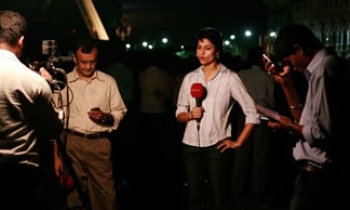Local news websites offering user-generated content are securing a valuable place in the media landscape and are likely to continue as important sources of community news, says a new report by US-based J-Lab: The Institute for Interactive Journalism.

"Citizen sites are developing as new forms of bridge media, linking traditional news with forms of civic participation," said J-Lab director, Jan Schaffer, author of the report, Citizen Media: Fad or the Future of News: The rise and prospects of hyperlocal journalism.
These sites, which take many forms, have rapidly emerged since 2004. However, rather than delivering comprehensive news and "finished stories," most sites are "forming as fusions of news and schmooze" that pay particular attention to key issues in their communities.
The key findings:
- Citizen media is emerging as a form of bridge media, linking traditional media with forms civic participation.
- No one size fits all; there are many models.
- Instead of being comprehensive sources of news, sites are forming as fusions of news and schmooze.
- Most citizen sites don’t use traditional metrics — unique visitors, page views or revenues — to measure their success.
- Success is often defined as impact on their community.
- Half of the respondents said their sites don’t need to make money to continue.
- Yet there are new kinds of media companies starting to emerge.
- There is a high degree of optimism that citizen news sites are here to stay.
- Finding ways to attract more contributors and some operating support are major challenges.
Many Cit-J sites, the report said, have grown out of small US towns such as Deerfield, New Hampshire, where citizens get little or no attention from any press organisation short of one of their number being murdered. They’re also rising from cities, including many aging Midwestern manufacturing areas such as Toledo, Ohio, and Muncie, Indiana, where activists complain that local coverage is diminishing as news organizations cut costs.
While citizen journalists don’t particularly aspire to be called “journalists,” 104 of 131 survey respondents (79 per cent) said they considered the content on their site to be “journalism.” In describing it, 46 per cent said it was mainly news and information; 31 per cent said it was mainly opinion and commentary, and 23 per cent said content consisted of “other” things. Stories (67 per cent), comments (65 per cent), photos (64 per cent) and calendar listings (55 per cent) were the most frequently cited types of content appearing on respondents’ sites. Other types included columns (41 per cent), press releases, (37 per cent) and videos (30 per cent).

Overall there was little accountability built in for content contributors: 73 per cent of all respondents said their sites didn’t require users to register; 69 per cent said a valid e-mail was not even required before posting. Only 40 per cent of 141 respondents said their sites required contributors to use their real names; 60 per cent said their sites allowed either anonymous posts or the use of “screen” names.
The report, funded by a grant from the Ford Foundation, was commissioned to determine the prospects for sustainability of these fledgling enterprises. It relied on in-depth interviews of 31 different sites and a 60-question, online survey that targeted 500 citizen sites that could be identified in the fall of 2006 and generated 191 responses.
"This report is the most comprehensive I have seen in documenting the community media revolution," said Dean Thomas Kunkel of the University of Maryland's Merrill College of Journalism, which houses J-Lab. "It quantifies what has been inherently difficult to quantify. And it shows in great detail how different entrepreneurs are employing different models and with different goals in mind."
Most citizen media ventures are shoestring labours of love, funded out of the founders' own pockets, and staffed by volunteer content contributors. While they would like more readers and revenues, site founders nevertheless professed a solid resolve to continue: 51 per cent said they didn't need to make money to keep going; 82 per cent said they planned to continue "indefinitely." Nearly all would welcome reinforcements and the ability to make even token payments to writers.
"While not all individual sites will continue to operate, we project that the phenomenon of citizen media will be sustainable, with new sites coming online in serial fashion to replace those that collapse as their founders burn out," Schaffer said.
A sizable majority, 73 per cent, of the survey respondents pronounced their sites to be a "success," based largely on the impact in their communities.
Respondents said their sites provided local news and information not found elsewhere, built connections to the community and helped local media to improve. Asked to describe community impact:
- 82 per cent said they provided opportunities for dialogue.
- 61 per cent said they watchdogged local government.
- 39 per cent said they helped the community solve problems.
- 27 per cent said they increased voter turnout.
- 17 per cent said they increased the number of candidates running for office.
Visit Knight Citizen News Network @ http://www.kcnn.org









